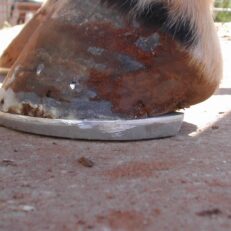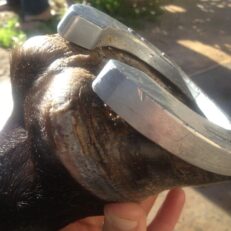In performance horseshoeing, with racehorses in particular, I have noticed lately that there seems to be an ongoing problem of horses going down on their bumpers, supposedly because of bad galloping surfaces. The bandaid used in Western Australia to overcome this problem is to use a graduated aluminium race plate on the hinds. The plate is graduated around three to five degrees higher in the heel than in the toe, supposedly to lift the horse’s heels up to stop them going down on their bumpers.
This is a very misguided bandaid, because the reason that the horse is going down on its bumpers in the first place is because the hoof pastern angle is wrong. The toes are far too long in relationship to the height to the heels so instead of looking at the toe, where the problem lies, they are putting on a three to five degree graduated shoe to lift the heel up and this is attacking the problem in totally the wrong way.
What needs to be done is for the horse’s hoof to be looked at in a different way, because in all cases I have found that where the hoof has a graduated shoe on the hind feet, they have equally as much overgrowth in the toe and if that is simply removed, there is absolutely no need to use a shoe with a graduated heel.
The big problem with a graduated heel, of course, is that it alters the stride of the horse by altering the flight of the hoof. A three to five degree graduated raised heel will actually cause that leg to leave the ground much quicker, travel higher and then drop shorter, which is about the last thing that anyone needs with a galloping horse or indeed with any performance horse.
Some horses I have looked at also had long toes and low heels in the front feet, some of them have short toes and high heels in the front feet as well as the graduated shoes on the hinds, so the poor horses are going nowhere. This is a huge problem that has crept into the style of shoeing in Western Australia and it must be stopped.
These poor horses are suffering from back strain and joint strain with miserable pain in the feet, and it can be eliminated purely and simply by correcting and balancing the hoof properly, then fitting a normal, standard, flat race plate or working shoe. The horses I saw with short toes and high heels in front have absolutely no chance of any frog contact or pressure with the ground, and are jarring terribly to a point where they are sometimes being shod with an aluminium shoe with a bonded rubber pad to stop the pain.
Once again, if the hoof was trimmed and levelled properly so that the weight bearing surface is set up correctly so that it can distribute the weight on the hoof together with considered frog pressure, then the horse will rehabilitate its hoof and start working properly. If the hoof is set up and balanced properly, it will have a correct hoof / pastern angle and the whole thing will work properly, but in the cases mentioned with high heels and short toes in front together with graduated heels behind, it is totally destroying the galloping action of the horses.
The problem of low heels and long toes is also fairly evident in these country areas of Western Australia. The result of this problem can be illustrated by looking at a white footed horse where you often will see red bruising or marks halfway up the hoof wall. Owners say ‘Oh that is just where the horse kicked a wall or kicked a rock or it was kicked by another horse etc.’ The marks are the hoof capsule tearing away from the laminae underneath and it is actually bleeding. If you push your thumbnail down on a hard surface you will see a red spot about halfway down, and it hurts. That is because you have applied pressure to a long thumb nail and it causes pressure in exactly the same way underneath that horse’s hoof capsule. The way to get rid of it is simply to reduce the flares.
With a properly balanced hoof, you will get rid of those flares and end up with a correct hoof / pastern angle, with considered frog pressure most of the time, and that will also rehabilitate the hoof. It all goes back to the simple basic principles of balancing the hoof properly and trimming it properly before you even think of putting shoes on it.
If a horse is not trimmed and balanced properly barefoot, then no one has any business to put shoes on it of any kind.



